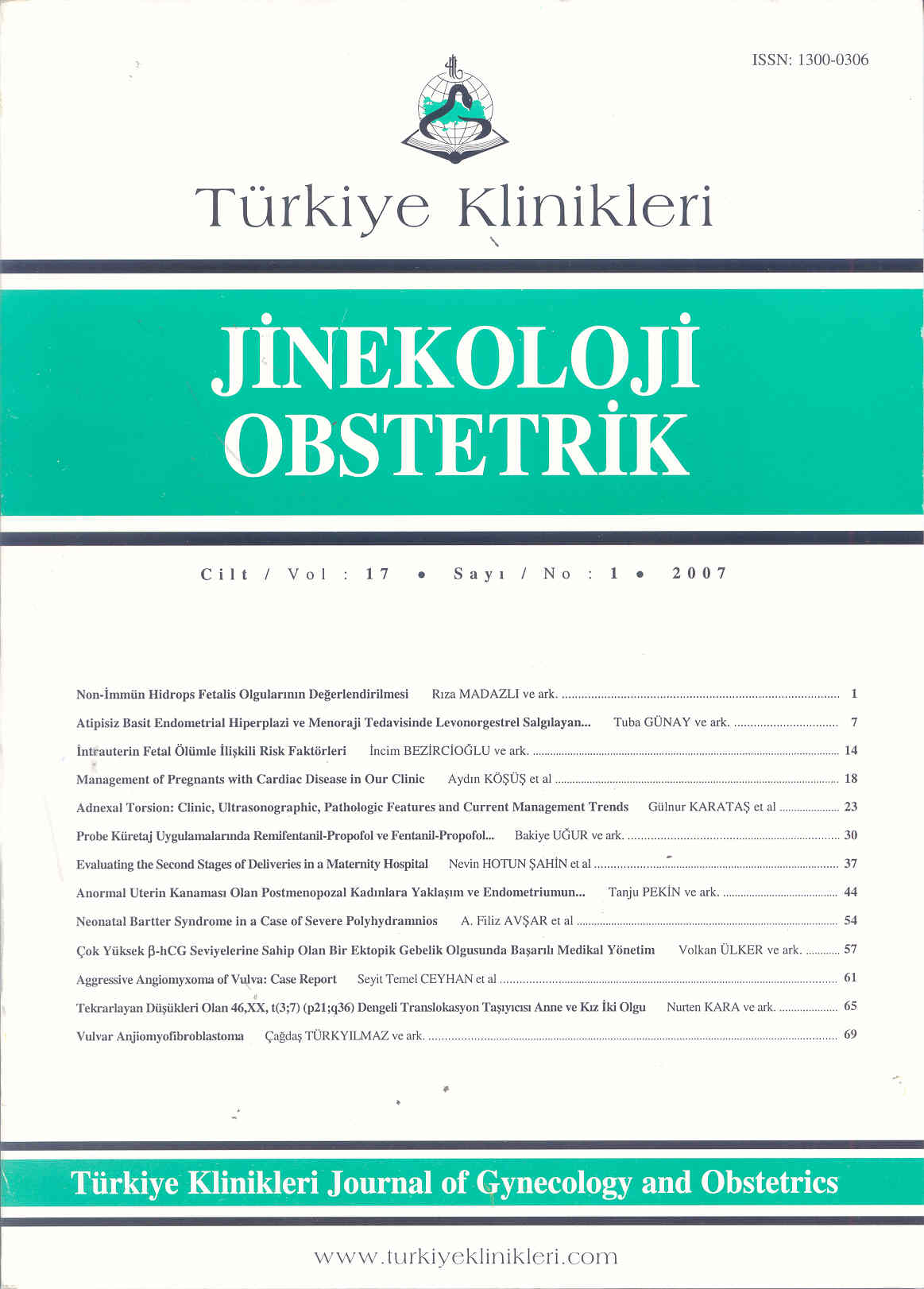Open Access
Peer Reviewed
ORIGINAL RESEARCH
2776 Viewed1354 Downloaded
Evaluating the Second Stages of Deliveries in a Maternity Hospital
Bir Doğumevi'nde Doğumların İkinci Evrelerinin Değerlendirilmesi
Turkiye Klinikleri J Gynecol Obst. 2007;17(1):37-43
Article Language: EN
Copyright Ⓒ 2025 by Türkiye Klinikleri. This is an open access article under the CC BY-NC-ND license (http://creativecommons.org/licenses/by-nc-nd/4.0/)
ABSTRACT
Objective: To determine properties the second stages of deliveries in a maternity hospital Material and Methods: The population of this observational and descriptive study included all women between 37-42 weeks gestation, who was expected to give normal spontaneous vaginal labor with single vertex fetus and who had no complications developed in pregnancy and labor by convenience sampling method. The progress of labor and all observations for mother and fetus were recorded to the partograph beginning from the admission to the delivery unit. An information form was administered for descriptive characteristics of cases. The data of the study were analyzed with SPSS. Results: 504 cases were included to the study. 51.6% of primiparous and 48.4% of multiparous women had spontaneous vaginal labor and mediolateral episiotomy. The length of first stage of labor was similar in primiparous and multiparous women. The length of second stage of labor in multiparous women was significantly shorter than primiparous women. (z=-5.759 p< 0.000). 92.50% of women received oxytocin induction. Fundal pressure was used in 42.5% of primiparous and 15.9% of multiparous women. Conclusions: The length of phases in the first stage of labor (latent, active and transition) was quite short in both primiparous and multiparous women. The length of the second stage of labor was also found shorter in primiparous than multiparous and the literature. Shorter labor stage was observed with the fundal pressure and the common use of oxytocin induction and routine episiotomy in the second stage of labor. Labor induced outcomes must be followed with longitudinal researches.
Objective: To determine properties the second stages of deliveries in a maternity hospital Material and Methods: The population of this observational and descriptive study included all women between 37-42 weeks gestation, who was expected to give normal spontaneous vaginal labor with single vertex fetus and who had no complications developed in pregnancy and labor by convenience sampling method. The progress of labor and all observations for mother and fetus were recorded to the partograph beginning from the admission to the delivery unit. An information form was administered for descriptive characteristics of cases. The data of the study were analyzed with SPSS. Results: 504 cases were included to the study. 51.6% of primiparous and 48.4% of multiparous women had spontaneous vaginal labor and mediolateral episiotomy. The length of first stage of labor was similar in primiparous and multiparous women. The length of second stage of labor in multiparous women was significantly shorter than primiparous women. (z=-5.759 p< 0.000). 92.50% of women received oxytocin induction. Fundal pressure was used in 42.5% of primiparous and 15.9% of multiparous women. Conclusions: The length of phases in the first stage of labor (latent, active and transition) was quite short in both primiparous and multiparous women. The length of the second stage of labor was also found shorter in primiparous than multiparous and the literature. Shorter labor stage was observed with the fundal pressure and the common use of oxytocin induction and routine episiotomy in the second stage of labor. Labor induced outcomes must be followed with longitudinal researches.
ÖZET
Amaç: Bir doğumevinde doğumların ikinci evresinin özelliklerini belirlemek. Gereç ve Yöntemler: Prospektif tanımlayıcı bu çalışmada 37-42. gebelik haftasında, verteks pozisyonda ve tek bir canlı fetüs ile normal spontan doğum yapması beklenilen, gebelikte ve doğumda riskli bir durumun gelişmediği gebeler evreni oluşturmuştur. Gebenin doğumhaneye kabulünden itibaren partograf üzerinde doğumun ilerleyişi, anne ve fetüsün tüm izlemleri kaydedilmiştir. Olguların tanımlayıcı özelliklerini içeren bir bilgi formu uygulanmıştır. Veriler SPSS analiz yöntemleri ile değerlendirilmiştir. Bulgular: %51.6'sı primipar ve %48.4'ü multipar toplam 504 vaka ile çalışılmıştır. Doğum eyleminin birinci evresinin süresi primiparlarda ve multiparlarda benzerdir. Doğumun ikinci evresi multiparlarda primiparlardan anlamlı olarak daha kısadır (z=-5.759, p< 0.000). Kadınların %92.50'sine oksitosin indüksiyonu uygulanmıştır. Primiparların %42.5'ine ve multiparların %15.9'una fundal basınç uygulanmıştır. Sonuçlar: Doğum eyleminin birinci evresinin fazlarının (latent, aktif ve geçiş) süresi hem primiparlarda, hem de multiparlarda oldukça kısadır. Doğum eyleminin ikinci evresinin süresi de primiparlarda ve multiparlarda literatürlerde belirtilenlerden oldukça kısadır. Doğum eyleminin ikinci evresinde fundal basıncın, yaygın oksitosin kullanımının ve rutin epizyotominin doğum eyleminin süresini daha da kısalttığı gözlenmiştir.
Amaç: Bir doğumevinde doğumların ikinci evresinin özelliklerini belirlemek. Gereç ve Yöntemler: Prospektif tanımlayıcı bu çalışmada 37-42. gebelik haftasında, verteks pozisyonda ve tek bir canlı fetüs ile normal spontan doğum yapması beklenilen, gebelikte ve doğumda riskli bir durumun gelişmediği gebeler evreni oluşturmuştur. Gebenin doğumhaneye kabulünden itibaren partograf üzerinde doğumun ilerleyişi, anne ve fetüsün tüm izlemleri kaydedilmiştir. Olguların tanımlayıcı özelliklerini içeren bir bilgi formu uygulanmıştır. Veriler SPSS analiz yöntemleri ile değerlendirilmiştir. Bulgular: %51.6'sı primipar ve %48.4'ü multipar toplam 504 vaka ile çalışılmıştır. Doğum eyleminin birinci evresinin süresi primiparlarda ve multiparlarda benzerdir. Doğumun ikinci evresi multiparlarda primiparlardan anlamlı olarak daha kısadır (z=-5.759, p< 0.000). Kadınların %92.50'sine oksitosin indüksiyonu uygulanmıştır. Primiparların %42.5'ine ve multiparların %15.9'una fundal basınç uygulanmıştır. Sonuçlar: Doğum eyleminin birinci evresinin fazlarının (latent, aktif ve geçiş) süresi hem primiparlarda, hem de multiparlarda oldukça kısadır. Doğum eyleminin ikinci evresinin süresi de primiparlarda ve multiparlarda literatürlerde belirtilenlerden oldukça kısadır. Doğum eyleminin ikinci evresinde fundal basıncın, yaygın oksitosin kullanımının ve rutin epizyotominin doğum eyleminin süresini daha da kısalttığı gözlenmiştir.
MENU
POPULAR ARTICLES
MOST DOWNLOADED ARTICLES





This journal is licensed under a Creative Commons Attribution-NonCommercial-NoDerivatives 4.0 International License.










